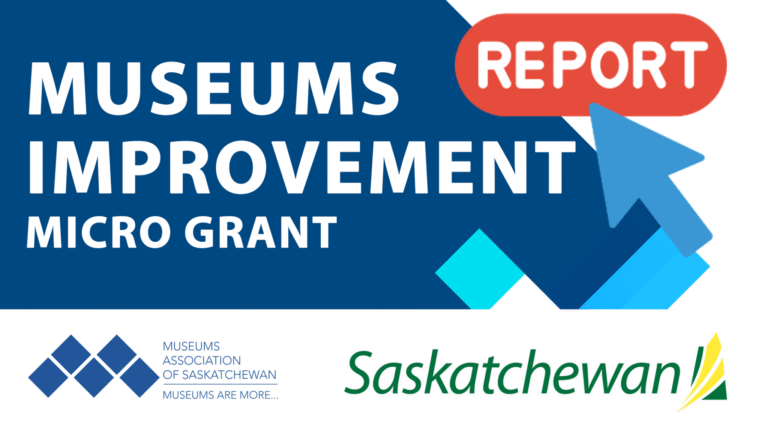
The MAS office will be closed for Christmas Holidays December 24th to January 4th.
Usual office hours will resume on January 5th, 2026
So much has happened in Saskatchewan during 2014: a brutally cold winter and then an extremely wet summer! Those two alone don’t seem like much, but the impacts of them have persisted for months; they might even still be continuing in your community.
You might not be able to stop the forces of nature, but you certainly can control how much they will impact you and your organization. Yes, we’re talking about emergency planning and response!
Often, planning for emergencies is overlooked until a disastrous situation occurs. However, if we begin to make plans to prevent, prepare, and respond to the situation, the impacts could be lessened; impacts such as loss of data, loss of collections, damaged facilities, stress, and possible loss of life.
Who isn’t in favour of that?
Emergencies and disasters come in various forms: from arson to flooding to a burst pipe. Being ill prepared (or not at all) may magnify an emergency situation. Something as simple as a burst pipe may not seem like a disaster, but if there is no one checking on the building or no one around who knows where the water turn off valves are, it could become a big deal! Similarly, if there are no materials or supplies around to mitigate the fall out, volunteers and staff could waste valuable time looking for places to purchase them thus increasing possible damage.
I don’t know about you, but I don’t think about disasters everyday (despite what it seems). But being informed and prepared prevents irrational and uninformed decisions from being made. When the panic sets in, it’s important to have a simple, practiced plan in place to follow.
There are 4 elements to a good disaster plan:
Prevention
Preparedness
Response
Recovery
Prevention means taking a serious look at your situation. Do you have a disaster plan? If not, you should probably make one. What are some possible hazards/impacts upon your site? Are there ways that you could work to reduce their impact? Talk to the RCMP or the local fire department about what these might be and what you can do about them. Communicate possible risks to them should they respond to an emergency on your site.
Preparedness means that everyone involved with the museum knows what to do when an emergency strikes. This includes having the disaster plan is in an accessible location and everyone knows what the contents of that plan are. Train staff and volunteers on what to do during and after the emergency. Practice! Drills are important for a reason.
Response is putting that plan into action! What are the emergency response procedures? What is the muster point? What are the priorities?
Recovery is the actions made after the disaster occurs to get back into working order. This is often the lengthiest process; it might take months or years to get back into working order.
Provinces, cities, towns, and municipalities all have disaster plans; check out yours. What elements does it have that you could use? Can you create one for your institution that could work in conjunction with the communities’? What aspects are important to add specifically for museums? Remember: a disaster plan is NOT just an emergency phone tree.
What’s in store for us during 2015? Who’s to say? But at least we’ll be ready in Saskatchewan!
Provincial Sources of Information:
City of Regina Emergency Planning: https://www.regina.ca/residents/emergency-planning/
City of Saskatoon Home Preparedness Plan: http://www.saskatoon.ca/DEPARTMENTS/Fire%20and%20Protective%20Services/EMO/Pages/Home%20Preparedness%20Plan.aspx
The Provincial Disaster Assistance Program (PDAP): http://www.saskatchewan.ca/live/public-safety-protection-and-emergency-services/recover-from-a-flood-and-natural-disasters
Saskatchewan Public Safety Protection and Emergency Services: https://www.saskatchewan.ca/live/public-safety-protection-and-emergency-services
Sources and further information:
American Alliance of Museums (2012). Developing a Disaster Preparedness/Emergency Response Plan. Retrieved on November 13, 2014 from http://aam-us.org/docs/continuum/developing-a-disaster-plan-final.pdf
Australian Heritage Collections Council (2000). Be Prepared: Guidelines for Small Museums for Writing a Disaster Preparedness Plan. Retrieved November 13, 2014 from http://www.collectionsaustralia.net/sector_info_item/2
Ball, Cynthia & Yardley-Jones, Audrey (eds). (2003). HELP!: A Survivor’s Guide to Emergency Preparedness. Edmonton, AB: Alberta Museums Association. Available at the MAS Resource Library.
Canadian Conservation Institute (1995). CCI Notes: 14/1 Emergency Preparedness for Cultural institutions: Introduction. Retrieved on November 13, 2014 from https://www.cci-icc.gc.ca/resources-ressources/ccinotesicc/14-1-eng.aspx
Canadian Conservation Institute (1995). CCI Notes: 14/2 Emergency Preparedness for Cultural Institutions: Identifying and Reducing Hazards. Retrieved November 13, 2014 from https://www.cci-icc.gc.ca/resources-ressources/ccinotesicc/14-2-eng.aspx
Dorge, Valerie & Jones, Sharon L. (eds) (1999). Building an Emergency Plan: A Guide for Museums and Other Cultural Institutions. Los Angeles, CA: Getty Conservation Institute. Retrieved on November 13, 2014 from http://www.getty.edu/conservation/publications_resources/pdf_publications/pdf/emergency_plan.pdf Available at the MAS Resource Library.
International Council of Museums (nd). Guidelines for Disaster Preparedness in Museums. Retrieved on November 13, 2014 from http://icom.museum/fileadmin/user_upload/pdf/Guidelines/guidelinesdisasters_eng.pdf
Patkus, Beth Lindblom & Motylewski, Karen (1993). Disaster Planning. Retrieved on November 13, 2014 from https://www.nedcc.org/free-resources/preservation-leaflets/3.-emergency-management/3.3-disaster-planning

Usual office hours will resume on January 5th, 2026

Just a reminder that the Final Report for the Museum Improvement Micro Grant for Community Museums is due December 5th! Your final report will require you to provide a brief

Thursday October 16, 202512:00pm CSTOnline via Zoom: https://us02web.zoom.us/j/86760471705?pwd=XjoSlWAP0TJZVYrprylmLqujOkVrk2.1 No registration required. The Museum Grant Program (MGP) provides operational funding to help foster strong, vibrant, community-based Saskatchewan museums that are valued